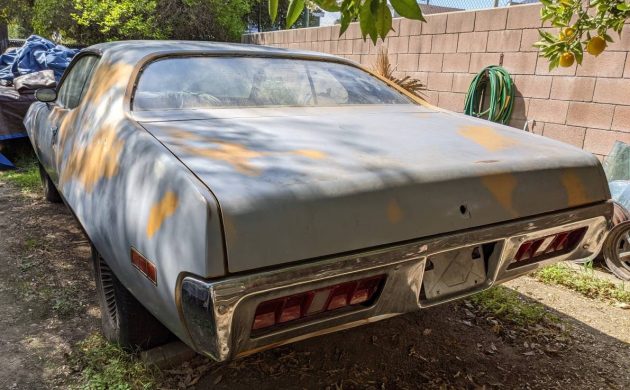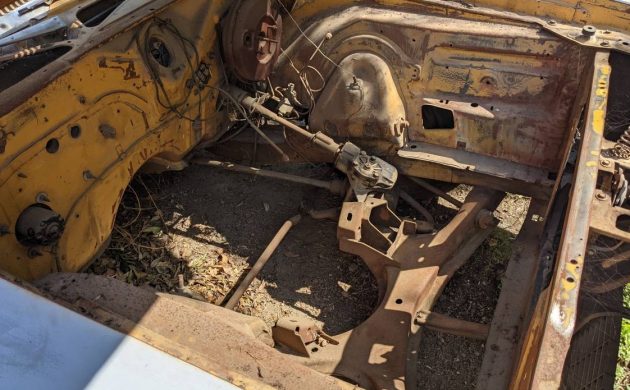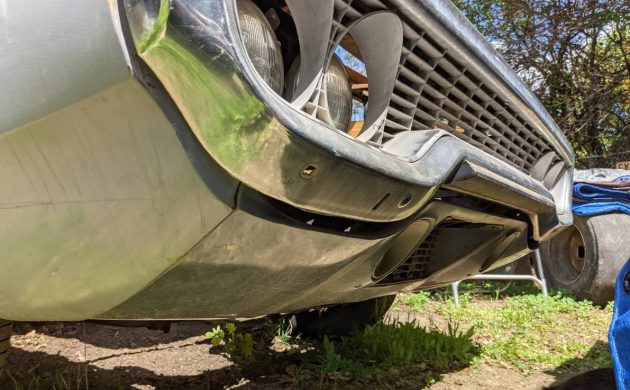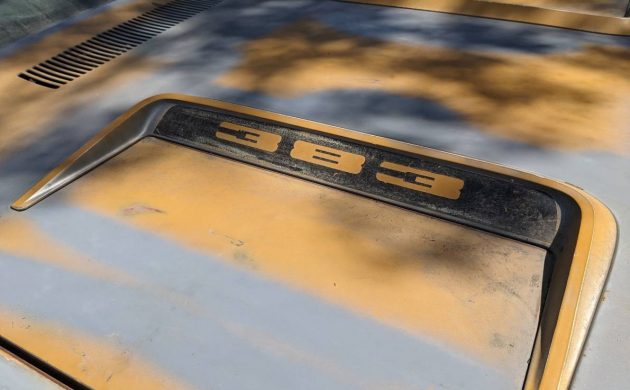UPDATE – This Road Runner was originally listed on craigslist. That listing has since been removed, but the car has now been listed here on eBay in Reseda, California where it’s currently bid up to $8,900.
This Gen II 1971 Plymouth Road Runner probably hasn’t had a good beep-beep! in some time. Seemingly loved by some and unloved by others (hate is too strong a term), this generation of Mopar B-Body can create a polarizing juxtaposition with its predecessor. The story on this one is light, so let’s check the visuals and see what we have. This Road Runner is located in Los Angeles, California and is available, here on craigslist for $22,000.
I had a real thing for the Gen I Road Runner, especially the ’68, it was exactly what Plymouth intended it to be – rough and ready. In late ’70, when I first spied the new ’71 model, I thought “Yuk”. Time, as is often the case has ameliorated my view, and I hold the Gen II in much higher esteem than I did so many years ago. How did the buying public view the change? Based on sales numbers, not very well. Sales numbers for the ’70 model year were about 41K, a sharp decline from ’69’s high watermark of 81K copies. The redesigned ’71 model saw only about 14K Road Runners who found owners – ouch! Was it styling, insurance premium surcharges, horsepower reductions, a tiring of muscle car madness, or all of it combined? Who knows, probably a mix.
Mopar’s tried and true 383 CI V8, now in its final year, continued to be the stalwart Road Runner powerplant. HP was decreased from 335 gross to 300 gross, ostensibly due to a compression ratio decrease. Changes were in the wind, forcing auto manufacturers to comply with the newly legislated Clean Air Act of 1970. And leaded gas was verbotten. It wasn’t going away, yet, but its demise was in the works as auto engine designers jumped on the bandwagon to design motors that would run on low-lead and no-lead fuel. This Road Runner’s claimed matching number 383 CI engine doesn’t require gasoline because it, and its matching TorqueFlite automatic transmission, are out of the car. There’s no image, just a shot of its number, so there’s no telling what shape it’s in.
Exterior-wise, this one-time Bahama Yellow specimen is not half bad. It’s a lifelong California car, so the moderate climate has been kind to it, more so than whoever went overboard with the gray primer and covered most of it up. There is no noted rust but the exterior images aren’t very comprehensive. Both bumpers and the grille look fair and it appears as if all of the glass is in place and not damaged.
The interior is another matter as it’s quite damaged, probably the sun having some culpability for the upholstery’s shredded condition. The carpet’s up, the floors are bare and there is some surface rust noted. Hopefully, for the next owner, the rust is no more than surface corrosion, or what is sometimes euphemistically referred to as “invasive surface rust” which I guess is what happens when surface rust breaks bad. There’s a rag or something on the dashboard, perhaps trying to either protect the dash pad or hiding the damage already done.
The seller suggests that this car is complete and will be an “easy restoration” – maybe so and maybe not, as stated many times before, the devil’s in the details and this listing is not exactly frothing with detail. I did a double-take on the price but I recall a comment made by a reader who reviewed this 1972 Road Runner post earlier in the week and he stated, correctly, that the perceived values of this generation Mopar are ascendant. That being the case, I predict someone will jump on this example at its price or something close to it, wouldn’t you agree?








No comments. Well, I’m not a Mopar fan myself, but a Nephew had a Sebring of the same vintage and color back in the late 70’s. His had a 318 and 904. I drove it a few times. It was basically a dog, but was okay for puttering around in. The body and paint were excellent as was the black interior. Now the thing about these Chrysler products that was always an odd thing to me was, if you wanted to put a big engine in one you also had to change the K member (cross member) as the oil pans were designed different. That’s all from me.
God bless America
It was primer grey?
Big block and small block K-members are the same. Slant six K-members and Hemi K-members are different, so go ahead and swap in that big block, just need to change motor mounts (obviously).
I might also add, that you maybe thinking of the A-body Barracuda / Darts which did use a Different K-member between small and big block, but on 71 B & E-body vintage cars, they are the same.
I like the original and fuselage designs equally. With the right buyer it could be a cool ride. Meaning someone who can do most of the work themselves, given the ask.
My favorite style of Roadrunner! Love the aggressive look of this body style!
My favorite RR/GTX body style but $22K for a basketcase? Unless the car is 100% rustfree (most likely not), it might fetch high teens. Maybe.
Don’t believe the horsepower ratings in 1971, the 383 was exactly the same as it was in 68-70. If you take the time to look up the rating you can see how Chrysler played with the numbers to help beat insurance surcharges for cars over 300hp. 1968-70 383 was rated at 335hp @ 5200rpm, 1971 was rated at 300hp @ 4800rpm. Wind that sucker out and those ponies were still there, your insurance man just didn’t need to know that.
I’ve heard your argument before but it doesn’t account for the fact the compression ratio of the 383 engine went from 9.5 in ’70 to 8.5 in ’71. A full point is going to clip some power.
JO
Nope, compression ratio didn’t drop, pistons have the exact same part number from 67-71. I’ve torn down several 383’s and have never found a different piston in 4bbl or 2bbl engines. The only thing that changed was on paper to make the insurance companies happy.
What about the head compression chamber size? Are you suggesting that Plymouth just lied? I would have a tough time believing that.
JO
I had a purple 73 340 postal grip 4 sp
Why did mopar make so many of these muscle cars automatic on the column? That just kills it for me
Mopar automatics outrun manuals on the track. Set up properly you can just leave them in drive and let the transmission do the gear changing for you. There is a counter weight in the tail shaft you can change to get it to shift at basically what ever rpm you want. The 727 is a great and easy to build transmission.
Column shifts were standard on cars equipped with automatic transmissions. Since this was budget oriented, buyers had to pay extra, most didn’t want to. There were several other makes such as 66 and newer Chevelle SS’s and Torino GT’s where floor shift automatics were also optional.
Steve R
I drove a triple black ’71 440 sixpack 4-speed dana 60 roadrunner once. But the guy wanted $2,200 so I passed on it.
I been there before, actually several times once on a Porsche 930 and a 72 Pantera that was a Grp.3 Tribute vehicle that the guy needed money. The Pantera is the on that hurts the most. I still have the pics!
I like the Plymouths from this era better than the Dodge Charger, this one is no exception. But the styling of the first gen RR’s has a simpler, almost menacing simplicity compared to these. Especially a ’69 1/2 six pack ‘Runner with black steelies, chrome lug nuts and a nasty hood scoop.
The numbers dont lie, many reasons for sluggish sales. Another one would be laying down a big chunk of change for a car that was slower than your “old” late sixties super street machine day 2 Road Runner. Why bother?
I loved my 72 Satellite Sebring Plus. Got used from a dealer
In 1975 for $2,100. Automatic attached to the 400 ci. Would chirp tires shifting from first to second. Once I got Cragar 5 spokes and 60 Radial TAs it looked so aggressive. I loved that car.
Hey Peter J, this looks like your car and place.
Text me if so.
And, when do I go to N M?
I’m a Mopar lover but 22k for a shell? Dream on.
1970 marked the year where Iran took some teachers hostages causing the gas shortages. Hence Honda’s cars, Vegas, and Pintos. the gas shortages came back in 1979, Gas then was sold on the basis of your plate numbers, meaning the first number of the license plates if it was a 9 of course it would had been the odd number, While 6 would of been the even number. This was enforced by the gas station, in the 1971 gas shortage a person would just simply sit in line until the gas station ran out of gas, or your vehicle ran out of gas, which would then have to be push unto the gas station’s pumps.
I don’t recall a fuel shortage in ’71, are you sure you don’t mean October ’73? It was fueled by the Yom Kippur war. I waited in plenty of lines from November of ’73 until about March of ’74, never waited in one in ’71.
Yes, you are correct, bad things returned in ’79.
JO
Sue,
I was driving in this year and in my area, which is all I can testify and state as fact and no gas stations were looking at plates and telling you it is not your day to fill up/etc..
Like now, this would have caused gas station attendants to get assaulted or worse. Imagine having your car near empty and having not known this alleged policy and having to go to work that day or travel out of town, only to let your boss know you could not get to work or that business meeting bc you lacked resp…Nope, this was not in my very populous state. NOPE..
THEE first created gas shortage was May 1973.
I was on vacation driving cross country when it jumped from about $.30 cents to $.49 cents.
I had several cars, a couple personalized plated cars, and odd and even numbers.
Never had to wait in line.
Drove 3 miles to work.
I accidentally had them all full of real leaded gas, and the unleaded scare did not scare us.
I just rotated cars as needed.
The 78-79 created shortage had a 10 gallon limit and so did big rigs. 50 gallon limit, was so stupid. More fuel wasted in lines and limits.
Fuselage body styles I had no interest and still don’t care for them today.
Best looking Road Runner ever…’69 and ’72 are a very close tie for second.